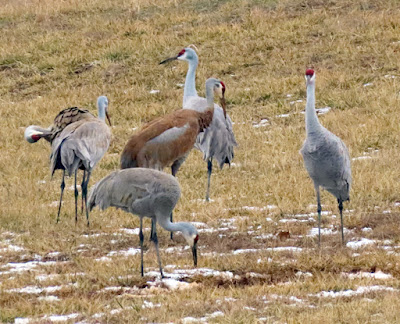 |
| Sandhill Cranes |
On Feb 11, as the snow started to melt, we decided it was safe to leave home, and went to look for cranes at the Cecilia fire station, situated in the middle of Hardin County farmlands. We found absolutely THOUSANDS of them foraging. These cranes are omnivorous, although in our area they tend to feed in corn stubble, avoiding the soy bean fields. Snow doesn't seem to bother them.
The range map shows them as mostly a western/central bird, the Greater Sandhill subspecies. But the Lesser Sandhills migrate right across our area in Kentucky. Unfortunately, they have a reputation as the "rib-eye of the sky," and hunting is permitted in Kentucky and Tennessee during a limited time. Every year we hear reports that Whooping Cranes have also been shot.
Sandhill Cranes mate for life, choosing their partners based on dancing displays. Displaying birds stretch their wings, pump their heads, bow, and leap into the air. Although each female usually lays two eggs, only one nestling typically survives to fledge. During migration and winter the family units group together with other families and nonbreeders, forming loose roosting and feeding flocks—in some places numbering in the tens of thousands.
“Marshland Elegy” is a chapter in “A Sand County Almanac and sketches here and there,”where Aldo Leopold tells the story of the noble Crane and of how the crane marsh has been displaced by the short-sighted and wasteful ‘progress’ of human beings.In the 1930s, Sandhill cranes were generally extirpated east of the Mississippi River but their populations have recovered with there being an estimated 98,000 in the region in 2018, a substantial increase over the previous year. The greater sandhill crane proper initially suffered most; by 1940, probably fewer than 1,000 birds remained. Populations have since increased greatly again. At nearly 100,000, they are still fewer than the lesser sandhill crane, which, at about 400,000 individuals continent-wide, is the most plentiful crane alive today.








No comments:
Post a Comment